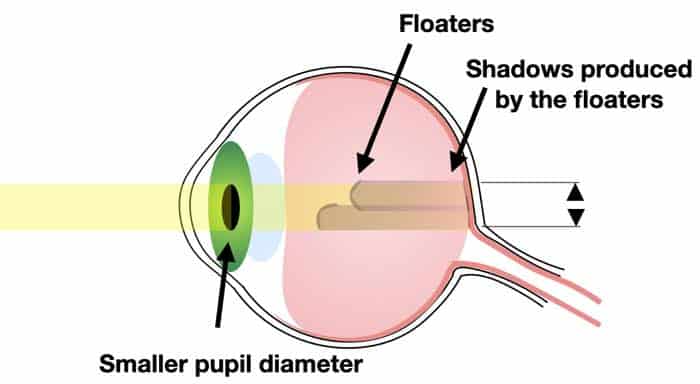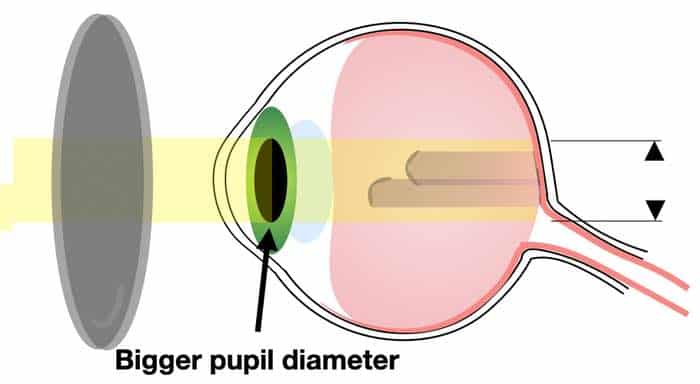The best glasses for eye floaters have a noticeable tint to them. After you read this article you will know why a tint would be beneficial and what options you have when it comes to the glasses.
Eye floaters come in different shapes sizes and some of them are more or less dominant. In a lot of cases they are most dominant in bright light. In those conditions your eyes adjust to the environment around you and your pupils diameter will be a little smaller.
Due to the smaller pupils a smaller bundle of light rays falls into your eyes. When some floaters are no positioned where the light bundle falls into your eyes a shadow will be formed in the back of your eyes. You can see an illustration of this in the picture below.

Now when tinted glasses are placed in front of the eyes your pupils open up and a bigger light bundle falls into your eyes. Although the shadows are still present in the back of your eye they become less dominant because of the smaller percentage of the light they block falling into your eye.
In the picture below you can see an illustration of tinted glasses for eye floaters. Depending on the reaction of your pupil you will have a bigger or smaller effect with those glasses.

What Options Do You Have With Glasses for Floaters?
When it comes to the tints the following options worked great for my customers in my optical shop:
- Photochromic lenses (transitions)
- Photochromic lenses with polarization (vantage transitions)
- Sunglasses with a tint of 85%
- Polarized sunglasses
My personal recommendation for peoples with eye floaters is to test the different options directly in bright sunlight. Out of my experience oftentimes the polarized options lead to a more satisfying result. The reason is when sunglasses are not polarized a significant blur like on a windshield will probably be still left. In such a situation your pupils tend to be more closed. And the floaters will be more noticeable.
Just look at the picture below. Here I was standing in front of a car. On the left side you can see the glare and mirror effects on the windshield and on the hood. On the left I was just holding a regular pair of sunglasses in front of my camera. On the right you can see the effect of a pair of polarized sunglasses.

If you compare the left and the right side you will immediatly see the missing glare on the right which is usually easier on your eyes when it comes to floaters. Because less glare will be in your be in your environment and therefore the floaters will be less dominant because of the bigger pupils size.
So after I tell those my customers a lot of them tend to buy the transition vantage option which is great. But they only tint darker when you are outside because the tinting process needs UV light.
When you sit in your car your windshield will probably have a UV blocker in it. The outcome will be you will practically have a very light tint in the car and practically no polarization effect.
Only if you step out of the car the full potential unfolds. So in most cases depending on how severe the floaters are my customers buy a variant of the transition lenses and polarized sunglasses for their car.
In the next part of the article I will describe the options when it comes to the tints of transition lenses in more detail.
Signature 8 Gen
The Transitions Signature 8 Gen is a lens that you cannot go wrong with for your bifocals. It is the main product of the transition lens. This transition lens is meant to meet the needs of most people, providing top-quality protection.
This lens version will take on a medium to dark tint outdoors, as well as completely clear indoors. It is meant for the everyday glasses wearer who is looking for something high quality and affordable. Transitions have dubbed these as the fastest reacting transition lenses on the market.
The switch from dark to light happens within two minutes. Depending on the light around you and the temperature this time may vary a bit.
Transition offers some solid non-polarized baseline colors for those that wish to keep it more simple:
- Gray
- Brown
- Graphite Green
They have also recently launched “style colors” if you are looking for more of the stylish look:
- Emerald
- Sapphire
- Amethyst
For those who may have a more active and outdoor life and are looking for some extra protection and customization towards their lifestyle, Transitions offers more versions that you may be looking for.
XtraActive
The Transition XtraActive lens offers more versatility to those that may enjoy the outdoors and sports more. While still offering the same UV and blue light protection as the Signature 8 lens, XtraActive differs in both tint and style.
One of the main differences with these lenses is in-car protection. Your car windshield will block most UV rays, which is why the regular transition lenses won’t react to light when in your vehicle. With XtraActive, the glasses will also react to other types of light, allowing you to drive more comfortably with less glare. They are still non-polarized.
Since these lenses are tailored to those with more of an outdoor spirit, these lenses will get darker outside and maintain a slight tint inside. This difference makes them ideal for outdoor wear while continuing to provide extra protection inside from blue light.
Transition is consistent with its baseline lens style offerings, with XtraActive available in:
- Brown
- Gray
- Graphite Green
The stylish options with XtraActive lenses is a lot different than the Signature lenses. This lens is the only one that offers the mirror style option. This style option creates a reflective and sophisticated look, with a slight tint indoors. The seamless transition from light to dark is amazing. There are quite a few more color options included:
- Silver Shadow
- Blue
- Gold
- Green
- Red
- Pink
Overall, the XtraActive provides a little more versatility and flair than the standard Signature lens. They also react better in a very warm environment and get darker. The time to switch from dark to a light tint is significantly longer. It takes approximately 8 minutes for them to get clearer.
Although this sounds too long at first for most people especially when people have to deal eye floaters they are satisfied with this tint because they darken up more compared to the regular transitions.
Vantage
The Transition Vantage lenses are the next step up from the XtraAction lenses. Tailored to the outdoors and sports lovers, these lenses are ideal for those that love hiking, fishing, and being outdoors in general.
Just like the other transition lenses, Vantage protects you from UV rays and other harmful light. This version of the transition lens is the darkest of the regular eyeglasses wear, as they will give you maximum protection outside and also have a slight tint while indoors. The indoors tint will also protect you from blue light more effectively.
One of the main features of the Transition Vantage lenses is that they are fully polarized when they are dark. While the lenses will still darken when exposed to light, the extra polarization will come in handy when hiking, fishing, skiing, snowboarding, and many more activities where the sun glare may be an annoyance.
These lenses make the ultimate transition lenses for the avid outdoor adventure seeker.
Transition does not specify on their website what colors and style options the Vantage series comes in, so out of my experience, I can tell you grey is the only option here, likely due to the additional feature of being polarized.
Driveware
The Transition Driveware lenses are a bit self-explanatory. This specific lens product is for driving. The windshield will block most of the UV light; however, the Driveware lenses are tailored to protecting you from bright lighting and keeping ease on the eyes.
The normal color of the lenses are green/yellow, and this is specifically to create a certain contract with the lighting outdoors to make it easier on your eyes.
Additionally, the colors will change to copper as well as a reddish-brown color depending on the lighting situations. The copper might help you see better when the lighting is dimmer, and it’s harder to discern details. The reddish-brown will occur when you are in a very bright environment, and maximum protection is required for your eyes.
Versatility against the different bright light and vision differences with colors are the main focal points to the Driveware lenses. They are great for both outdoors and in but ideally suited for driving when you’ll encounter all the different lighting scenarios.
Since the colors are important to how these lens work, there aren’t different style options.
In Conclusion
There are many different tints lenses you can choose to make the eye floaters less dominant. The best way to choose one is to identify which one fits your lifestyle the most. Just go to your optical shop and they will show you all the options described above.
Just make sure you go there when the problems with the floaters are present. Otherwise, you can not really tell if the tint has the desired effect.
I hope you found the information about glasses for floaters you were looking for.
I wish you a great day.
